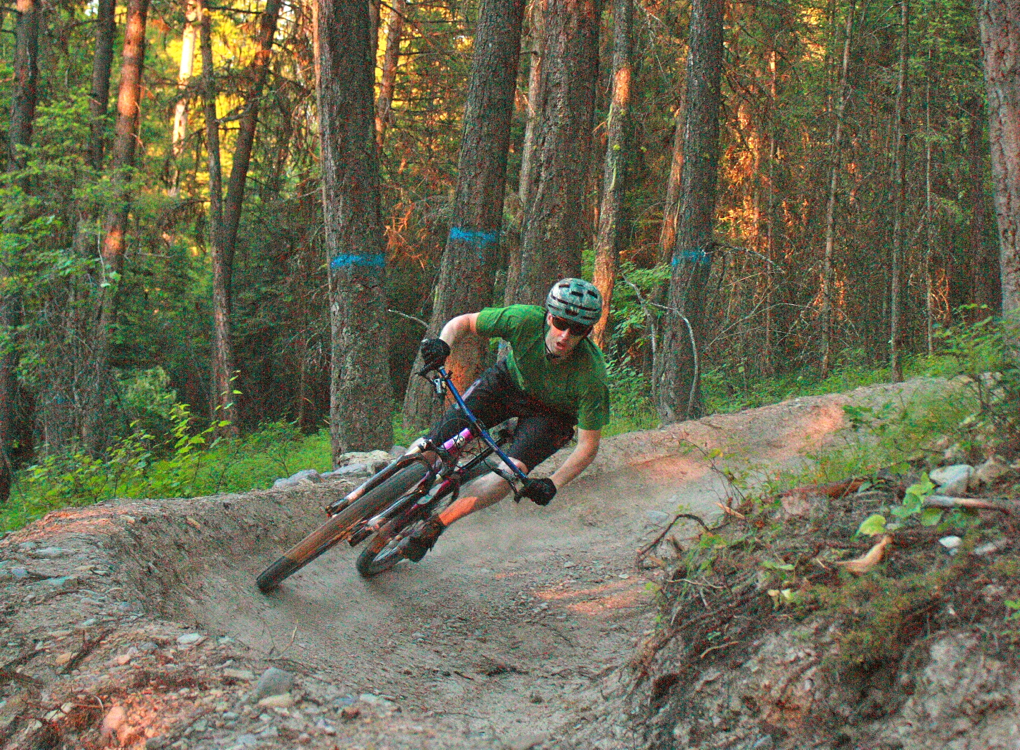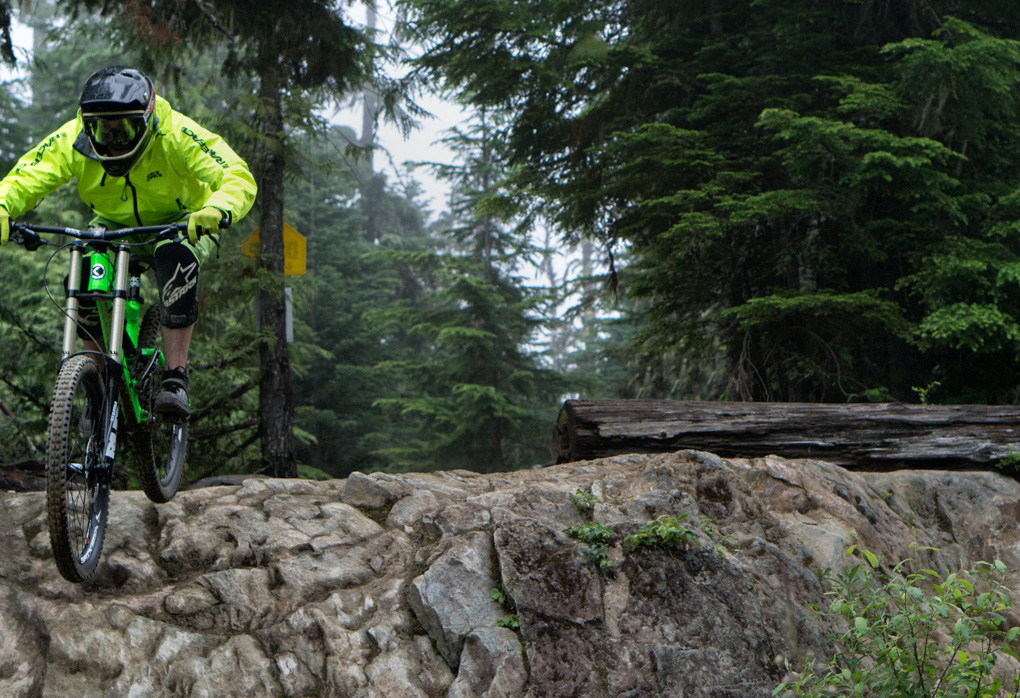Q: Other thoughts?
Noah: Travel is there for three reasons. The first is to keep you in control over rough terrain. You don’t really need much travel for that on the vast majority of trails out there, particularly those of the newer, smoother variety.
The second reason is to reduce fatigue over long rides. Again, you don’t need all that much travel to achieve this end.
The third reason is that (whether they’ll admit it or not) lots of people—myself included—like more travel because it masks mistakes. Line choice on a rigid bike means placing your tires in the exact right place at the exact right time. Line choice on a 160mm-travel bike means casually avoiding obstacles that can appropriately be described as “trees” and “boulders,” and otherwise pointing it straight. Any idiot can flounder down a moderately technical trail on a long travel bike. You can run into stuff and it just doesn’t matter.
Some people make a lot of mistakes because they’re pushing their limits and pinning it. Some people make a lot of mistakes because they pretty much just suck at riding a bike.

People in either of those categories can have a bunch of fun on long travel bikes. They just have to balance their love of blowing past mistakes with their willingness to drag a relatively heavy, relatively inefficient bike uphill.
I’d also add that there’s an ever changing dynamic of bike geometries, bike travel, and trail styles. It used to be that bikes were steep, tall, didn’t have much travel, and the trails we were riding were more likely to be slow and techy. Now there’s lots of “flow” trails getting built that are much faster, much less technical, and favor a shorter travel, lower, slacker bike.
Popular bike designs, including geometry and travel classes, have a direct relationship with the trails people are riding. As trail design evolves (whether for the better or the worse, depending on your preferences), so too do the bikes. That’s why lots of people are trending towards shorter travel bikes with modern geometry, and also why the few bastions of technical riding (British Columbia, parts of Utah, etc.) still have a disproportionate number of longer travel bikes.
Marshal: Many people seem to care about the things which are least important to me: travel and geometry.
For a long time, geometry and suspension quality totally sucked, and finding a bike that worked properly was really hard, and it was easy to discard most bikes on the market and find one bike purely off those two statistics.
Modern suspension is so good, you just don’t need as much travel as once required, and geometry has finally caught up as well.
For me and where I ride, it has been all about minimizing the last year or so: what is the least travel, best pedalling, most controlled yet fully active rear suspension? What are the fastest rolling and lightest tires that don’t compromise on traction or durability? What is the most efficient pedalling position that does not give up handling on the down?
In my opinion, here’s a great example: The EWS is elite pedal-accessed multi-stage timed downhill racing. Those cats are on 140-160mm rear travel bikes. In my estimation, unless you are pedal accessing real deal downhill trails and riding them with very fast speeds, most people just don’t need a bike that big. You are way better off (a) getting an appropriately efficient bike so you can ride more vert in a given hour or two, and (b) learning the required skills to shred on it.

Tom: As Noah and Marshal describe, how and where you ride matters a lot. Riding precision can make up for travel, and smooth trails don’t benefit from excess travel. Conversely, sloppy riding and/or rough trails often benefit from every millimeter of travel available.
To that end, long and short travel bikes can provide a great way to handicap riders and level the playing field. Intermediate riders will likely be able to ride more challenging terrain if they are put on a longer travel bike. An advanced rider can squeeze more fun out of easy trails by riding a shorter travel bike that requires them to more carefully and precisely choose lines through rough sections.
The one thing I haven’t discussed yet is my belief that wheel size matters a lot. I find that with 29” wheels I don’t need as much travel to monster truck over rock gardens. The bigger wheels smooth out the trail enough to negate the need for quite as much travel. Very unscientifically, I’d put them down as equal to 10-20mm of suspension travel.
If you haven’t spent time on a short travel bike in a while, do it. It reveals any bad habits you’ve developed and can make old trails exciting again. If you haven’t ridden a long travel bike, get on one and ride some hard trails, you may surprise yourself.
Variety keeps biking fun. Don’t get too set in your ways.

Suspension tuning and style wasn’t mentioned much. I’m not an expert tuner or anything, but even with flipping through dials and playing with air pressure, bikes, just like skis, do tend to have a certain personality of sorts. For example, lively, poppy and playful vs plush, stable and planted. For example, I found SB66s to feel more like the former (and skittish) and Nomads to feel more like the latter (and sluggish). Some of this could be geometry, but I think suspension characteristics are definitely playing a large role in the personality of the bike. I’m surprised this wasn’t mentioned by anyone. As an aside, I think shorter travel bikes are better suited towards the former, and longer travel bikes better suited towards the latter. I haven’t really looked at 275ers, mostly because they seem like a really poor allocation of my dollars with so many good 26ers going for dirt cheap (2 good bikes for the price of 1 mediocre, anyone?).
Really enjoyed this article. Great insights all around. I’m just going to need to convince the wife that I need a minimum of 3 mountain bikes. I’m sure it will go over great (haha). Lindahl, they actually have multiple articles on suspension including one that goes into a decent amount of depth on tuning your ride. Just go back to mountain biking 101 and you can find all the links there. Completely agree with your comment on the low prices of 26ers – unreal.
I’ve basically been in cryo-storage for the last decade as far as mountain bikes are concerned so this might be a question with an obvious answer but why aren’t there more long travel 29ers out there? I recently bought a Niner WFO and while I’m very happy with my purchase, there definitely isn’t the same level of selection in this category as there is in the LT 650b category. For instance, why doesn’t Santa Cruz make a 29er version of the Bronson? Is this a VHS / Beta question where one type of frame won the day “because”? Did these bikes initially come out and no one bought them? Are long travel 29ers the mono-skis of mountain biking? I’m obviously missing something. Interested in your thoughts. Thank you!
Andrew
When I first got onto a 29er this summer, my thought was that bigger wheels are to mountain biking what tip rocker is to skiing: they make the sport easier to do and therefore more accessible, more fun, etc. They’re not better than smaller wheels in every situation but in places where greasy roots and steep technical trails are common, I would imagine most riders would be happier on bigger wheels than smaller. So, when I started looking around for a new bike I was expecting to find lots of companies adopting them, across the spectrum of bike types, especially on enduro bikes. But what I found was that it’s mostly XC / trail bikes with less aggressive geometry and shorter travel (Santa Cruz Tallboy, Trek Remedy, Scott Spark, etc.) that have adopted 29″ wheels while the popular enduro (aggressive, long travel) bikes from Santa Cruz, Pivot, Devinci, Yeti, Norco, etc. are all 650b/27.5 – why is this? Maybe it’s because relatively short travel but aggressive 29ers like Evil’s The Following are facilitating the same kind of riding experience a LT 650b/27.5″ bike does (i.e. you don’t “need the extra travel because of the bigger wheels… but since when does that line of thinking apply to mountain bike manufacturers)?
Being short at 5’8″ and the lack of longer travel 29ers ruled wagon wheels out for me. I don’t buy the argument that the bigger wheel make up for 20mm of travel. Travel is travel. The real reason you don’t see long travel 29ers is that your already higher on them so longer travel would negativity impact the handling of the bike and create geometry issues. 140mm 27.5 hits the sweet spot for playful trail riding for me personally. I don’t care for flowy groomed trails so xc short travel bikes aren’t for me.
One more vote for the importance of the trails you ride:
Sure, langer travel bikeswap with slacker head angles climb very well these days.
So, out in the big mountains, you climb for 2 hours, then rip a sustained descent for 45 minutes, that’s a great set-up
On our Midwestern trails, much of the distance of a trail is spent on short rolling hills.
Having a bike that is lively pedaling out of the saddle on a short rise, having geometry that is nimble for the tight turns at slower speeds on the flats, and having firm suspension to pump every little feature, even on the uphills, makes that bike a lot more fun on these sort of trails.
So I’d argue there IS STILL a penalty for longer travel, slacker bikes.
Great article, give me more insights. Written well. We need more article like this in different subjects
Thanks
Beeson,
I am just under 6′-0″ and I feel that the 29ers with long travel are just way to Tall. I do not like to maneuver on stilts, and I would need a Medium with 29 and anything over 130 mm travel. also at some point the suspension will tweak, bind, or feel like it is hanging up as you are flicking around corners or clipping rocks.
I tend to use my dropper any time I see Technical or tight turns, and the high profile only helps for pedal strikes… not confidence in riding my outside lugs. We need a lower center of gravity without grinding down front cogs.